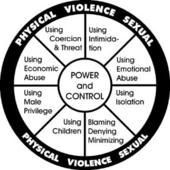What is the Difference
Between
D/s, BDSM
and Domestic
Violence/Abuse?
W/we are also aware that there are some who inappropriately label their adult abusive relationships as D/s or the abuse as BDSM activities. Whilst this may in some way make the abuse more palatable or acceptable to the perpetrator and the victim, such semantic re-packaging creates a false perception of what is involved in a D/s relationship. D/s and domestic violence/abuse are diametrically opposite.

My experience of D/s originates from an adult life lived solely on this life path. This has been supplemented by University studies including Bachelor of Social Work (1985) with a minor in Sexology, specialising in paraphilia's: specifically D/s and BDSM and over 21 years of clinical, field, policy and legal work in the areas of adult and child sexual abuse and family violence.
In order to examine the differences between abuse and D/s and BDSM it is sensible to first get a grasp on what is abusive behaviour in intimate relationships. This is a difficult concept to grasp for many, but essentially domestic/family violence is a cycle of behaviours which are repeated over and over again. There are several patterns that form the cycle and W/we will first look at this.
This will be followed by postings on the elements of D/s relationships, Safe, Sane and Consensual principles, a look at the elements of BDSM (including legal issues) and finally a recap of the identified differences. The final posting will offer information on services
Domestic/Intimate Violence: The Cycle
The abuse can be physical, verbal, emotional, or sexual. Often, one or more intimidating and/or violent incidents are accompanied by an array of other types of abuse. They may not be as obvious, but the presence of others assist in indentifying a pattern of intimidation and control in the relationship.
injury and death to women
between the ages of 15-44,
exceeding car accidents,
muggings and rapes.

Domestic violence
not only affects
the abused victim,
but it also affects
the children who witness
the abuse.
Statistics indicate that domestic violence
is the single best predictor
of juvenile delinquency
and adult criminality
and has a grievously devastating effect
on self esteem,
functionality,
socialisation and
confidence.
Tension Building Phase
This is the phase where the tension starts to almost imperceptably build; like a mood or a dark cloud permeating the home..... things lead up to that "walking on eggshells" feeling.Acute Incident Phase
Progression of violence:
- pre-battering violence
- verbal abuse
- hitting objects
- throwing objects
- breaking objects
- and making threats
when abusers hit or break objects or make threats almost 100% resort to battering - beginning levels
- pushing
- grabbing
- restraining
- moderate levels
- slapping
- pinching
- kicking
- pulling out clumps of hair
- severe levels
- choking
- beating with objects
- use of weapons
- and rape (1 in 3 women in a violent relationship are raped)
- batterer uses weapons to subdue victim
- victim is afraid of consequences of batterer getting angry if they say no
Honeymoon Phase
If the victim does leave after the battering incident the batterer will do anything it takes to get them to come back. This includes:
- "hearts and flowers" (bribe)
- promises to be a good parent (works well if they have neglected the kids)
- finds God (does not take responsibility for behavior)
- will stop drinking (drinking does not cause battering)
- will get counselling (only long term counseling will be effective and less than 1% voluntarily go into counselling).
Tags: bdsmabusevsbdsm1 Tuesday January 16, 2007 - 02:16am
Thank you raven, as always. As you know there are misconceptions; i'm looking forward to the remaining postings. *points a few people towards this blog* Hugs
Monday January 15, 2007 - 10:50am (EST)
As a college freshman, I did a Writing 103 term paper on child abuse where I got lots of books on the subject from my next door neighbor, who is retired now from law enforcement. I still wince and cry when I think about the brutality and the abuse the kids took. I know it isn't quite the same as what the article is, but that term paper reaffirmed that I will NEVER be a person that could ever batter a woman or a child.
Monday January 15, 2007 - 05:50pm (GMT)
Thank You for bringing this to the front, this is an awful situation that many ppl have endured to many degrees and in many fashions, perhaps some take for granted that because they dont "actually" hit a person then it it isnt real abuse, emotional and mentle abuse is sometimes subtle, but is NO less as damaging..i look forward to more post on this subject, brilliant as always sis...
Tuesday January 16, 2007 - 08:34am (EST)
fabulously informative as always...ty blonderaven sis...in the USA there are many resources for helping victims of abuse...*prays for the abused ones, hoping they have the strength and courage to stand up and reach out to someone for help*...i too look forward to more posts on this subject...thank you so much...what you share helps us to help others...God bless you girl! *hugs you so tight*
Tuesday January 16, 2007 - 09:22am (EST)









No comments:
Post a Comment
Comments